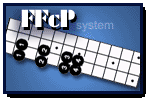« Improvisation: Ensemble Hatching |
Main
| Three's company. 3-note chord »
 February 3, 2011 | Review: Principles of FFcP February 3, 2011 | Review: Principles of FFcP
For many of you this is old news, but we like to bring all neophytes up to speed on the importance of FFcP, a foundational pedagogical strategy, a quick, caffeinated approach to understanding the entire mandolin fretboard. The TEF versions of these exercises were recently posted on the main page of the Mandolin Cafe along with its recent exponential expansion in resources of its TEF database. We don't personally use TEF a lot, preferring traditional notation and occasionally TAB, but if this helps to internalize the fretboard, all the power to you. Of course, you will need to install the TEF software, but there's a link for you on the page.
Cafe link: TablEdit FFcP
 Back to FFcP, the notion is explained in depth on the site here: Intro to FFcP. We show how you can move a simple one octave scale starting on your 1st finger, back a fret, up a string, and over a fret again to give you four different scales with the same fingering. Where this gets good is when you start the scales with the 2nd, 3rd, and 4th fingers, you develop an entire system of movable scales, covering all twelve with only four unique fingerings. It's all based on the scale relationships. You aren't thinking twelve keys, you're thinking four fingerings, and this eventually sets you up for more efficient improvisation thinking note relationships, rather than specific keys. Back to FFcP, the notion is explained in depth on the site here: Intro to FFcP. We show how you can move a simple one octave scale starting on your 1st finger, back a fret, up a string, and over a fret again to give you four different scales with the same fingering. Where this gets good is when you start the scales with the 2nd, 3rd, and 4th fingers, you develop an entire system of movable scales, covering all twelve with only four unique fingerings. It's all based on the scale relationships. You aren't thinking twelve keys, you're thinking four fingerings, and this eventually sets you up for more efficient improvisation thinking note relationships, rather than specific keys.
And it's all based on the Major Scale, one of the simplest components of Western European and folk music.
When you sing, you don't think key. You think how each note relates to the ones before and after. If you're more advanced, you're thinking them in a harmonic context, but the importance again is on the sound and its function. With FFcP, you're doing thes same thing, only with your fingers instead of your vocal chords. It takes a little time to train the muscles (4 to 6 weeks, sometimes longer), but eventually a light comes on and this all makes sense. If nothing else, a beginner can start developing good finger posture and fretboard familiarity.
Singing is done with very little conscious effort about where your vocal cords go to produce pitches, even in trained professionals. Your fingers ought to be able to respond subconsciously in the same way, and the FFcP is a relatively fast track to that skill. It's not uncommon for us to get reports back from readers several weeks into these studies that report a new aesthetic experience of "the notes just come from out of nowhere" when they start to solo.
It's a beautiful thing. If you haven't experienced this on your mandolin, there's no better time to start than now.
Review: Principles of FFcP
- In this system, there are only four ways to play a major scale: starting with the first finger, the second, the third and the fourth. That's it!
- All 12 keys can be covered in only four different positions, simply by transposing up or down the fretboard and across strings.
- 4th Finger (Pinky) strength and coordination become part of daily development exercises.
- Key Chord Tone relationships in improvising become tactile, visible, and intuitively real.
- Position shifts to a second octave are easily bridged merely by starting the next octave with a different FFcP pattern.
- Changes in tonal "micro-centers" by half steps easily transist either by moving the pattern by one fret, or using the next FFcP.
Further:
"The notes seem to come from out of nowhere."
Stuff you can get for free at JazzMando
Moving on up. And around.
Numbers.
FFcP Index
Posted by Ted at February 3, 2011 12:43 PM

Disclaimer: In the 'Information Age' of the 21st Century,
any fool with a computer, a modem, and an idea can
become a self-professed 'expert." This site does not
come equipped with 'discernment.'
|



